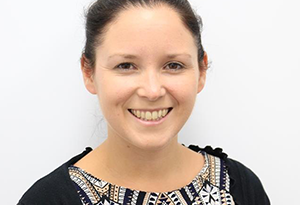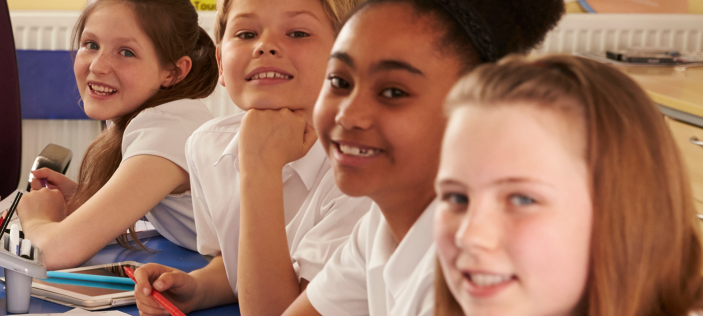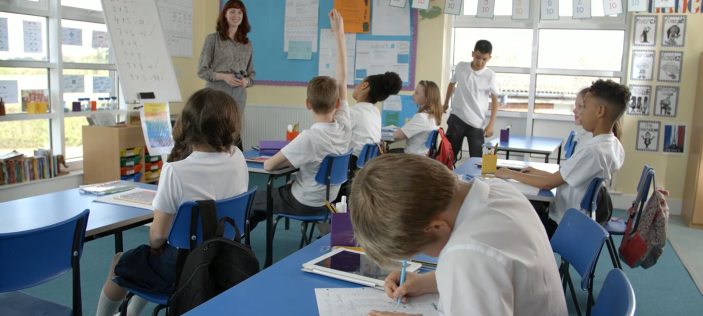
In 2024, 231 teams from across the UK and overseas took part in the annual HFL Education Year 5 Maths Challenge.
Of those, 30 teams made it through to the final, where they tackled in-school challenges and 3 live rounds of questions, resulting in joint winners:

Our favourite question was the pathways question because it was challenging, and we had to work as a team, which is what the maths challenge is all about.
Year 5 team, The Orchard Primary School
When life brings you maths, do the maths challenge!
Listen to the Year 5 team from Codicote Primary School, along with headteacher, Liz Pollard, talking to Andy Collins on BBC Three Counties Radio about their experience of the HFL Education Year 5 maths challenge 2024 and their future aspirations.
Registration is now open for the 2025 Year 5 Maths Challenge.
View the event guidance and practice questions.
Top tips for success
Let’s take a look at some of the questions from the 2024 Year 5 Maths Challenge to exemplify the types of problems teams will solve in this year’s challenge.
Let’s begin with the ‘pathways question’ referenced by the team from The Orchard Primary.
Tips for success to solve problems with ‘parts’

In the final, teams had two minutes in which to solve this problem. So, speedy decision-making and teamwork were the keys to success.
70% of the teams in the final got this question correct.
We recommend that teams distribute roles in these types of questions, for example, taking a pathway each to work along step by step, solving the calculations as they go, and then coming together to agree which pathway resulted in 15.5 (pathway C).
With any time left in these types of questions, it’s a good idea to swap roles within the team to check for accuracy.

70% of teams in the final gave the correct answer of ADCB.
Our top tip for teamwork: Share the question among the team and apply roles to work out different aspects.”
Year 5 finalists, Applecroft Primary School
Tips for success with estimation
Round 2 in the heats (and in the final) is the ‘estimation round’. Each correct answer in this round is worth up to 10 points. Marks are awarded in ‘zones of closeness’ and decrease incrementally as the distance from the ‘exact’ answer increases.

For this question, the full 10 marks were awarded to teams who estimated 415km.
Team answers ranged from 300km to 550km with one team’s estimate being spot on. Seven teams estimated 450km, making this the most common final answer. Teams were awarded 6 marks for this answer.
For this type of visual estimation problem, an understanding of scaling is required. Teams must use the information they are provided with to come up with an estimation.
I can see how a distance of 50km is represented on the map.
I must estimate how many of those 50km lengths would need adding together to equal the length of the line joining the two schools.

For this question, the full 10 marks were awarded to teams who estimated 30cm2.
Team answers ranged from 23cm2 to 53cm2 with three teams’ estimates being spot on. The most common final answer was 40cm2, given by 11 teams. Teams scored 6 marks for this answer.
We enjoyed this question the most because it was fun to estimate and work as a team.
Year 5 finalists, Pirton Primary School
Tips for solving problems in context
For some questions, the calculations required are not immediately obvious. Teams must use the information provided to work out the calculations needed.

For problems like these, we recommend teams take a moment before calculating anything, to discuss what’s known and what isn’t… yet.
We know that percentage means ‘an amount in each hundred’.
We know that a whole circle represents 4 sweets.
Two ways to work on this problem would be:
- Work out how many sweets were in the packet in total and then find out the percentage of those eaten by Josh.
- Work out how many ‘equal parts’ are represented in the pictogram and use this information to work out the percentage eaten by Josh.
If teams went down the second (arguably less error-prone) route and noticed that overall, there were ’10 whole circles’ represented in the pictogram, the rest was simple. Each ‘whole’ would be worth 10% and therefore, Josh ate 7.5%.
If teams went down the first route, the discussion may have sounded a little more like this:
We don’t know how many sweets there were in total… yet.
There are several strategies that could be used to work out how many sweets were in the packet in total, including:
- Calculating how many sweets are represented in each row (16 + 10 + 3 + 11 = 40)
- Counting the whole circles (8) and combining the parts to create further wholes (2) and then multiplying by 4
We know how many sweets were in the packet: 40.
We don’t know what percentage were eaten by Josh… yet.
We know that a whole circle would represent 10% (4 out of 40) so we know that Josh ate 7.5%.
90% of teams in the final answered this correctly.
HFL Education Year 5 Maths Challenge 2025
In the live heats in February 2025, teams will tackle 15 problems from across the maths curriculum. These will include questions with parts, problems in context and an estimation round. Teams will also tackle three ‘Perplexing Problems’ in school before their heats.
Examples of these can be downloaded:
Registration is now open for the 2025 Year 5 Maths Challenge (February 2025)
2025 Year 4 Maths Challenge (April / May 2025)
2025 Year 3 Maths Challenge (June 2025)
Find out more about the HFL Education Maths Challenges for Year 3 to Year 8



